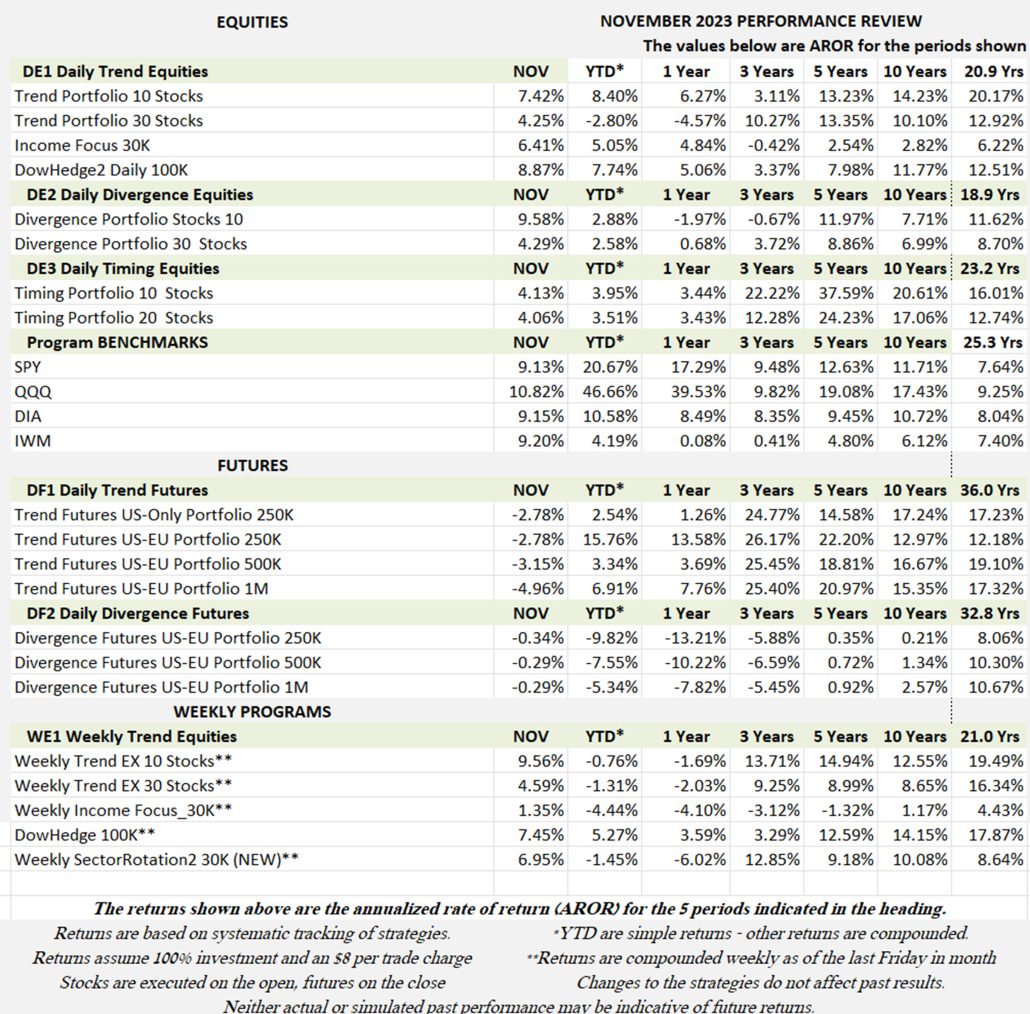
Industry Benchmark Performance
Reports show that November recovered from October losses, moving the equity index markets to profits. Now that the Fed seems to have indicated that it is done raising rates, the market may start to trend. CTAs however have yet to find the same trend.

Kaufman’sMost Popular Books (available on Amazon)
Trading Systems and Methods, 6th Edition. The complete guide to trading systems, with more than 250 programs and spreadsheets. The most important book for a system developer.
Kaufman Constructs Trading Systems. A step-by-step manual on how to develop, test, and trade an algorithmic system.
Learn To Trade. Written for both serious beginners and practiced traders, this book includes chart formations, trends, indicators, trading rules, risk, and portfolio management. You can find it in color on Amazon.
You can also find these books on our website, www.kaufmansignals.com.
There is a good website for trading books, Shepherd.com. Well-known traders recommend books and explain why.
Blogs and Recent Publications
Find Mr. Kaufman’s other recent publications and seminars at the end of this report. We post new interviews, seminars, and reference new articles by Mr. Kaufman each month.
November Performance in Brief
A reversal from October with more gains, hopefully indicating a new trend in equities. All programs, except futures, had larger than normal gains. We’re hopeful about December.
Futures have been mostly sideways in November, with very few positions. As of yesterday, we took our first LONG bond position. It’s been a long time. That means there is a significant turn up. Given that, we should see the dollar declining and other trends surfacing.
Major Equity ETFs
It’s a breakout! After 2 years NASDAQ (QQQ) and the DOW (DIA) have moved out of their sideways range and are likely heading up. Given the strange year of on-again, off-again tech and semiconductor gains, this gives all indications of a new trend. So far, only the IWM is not participating.
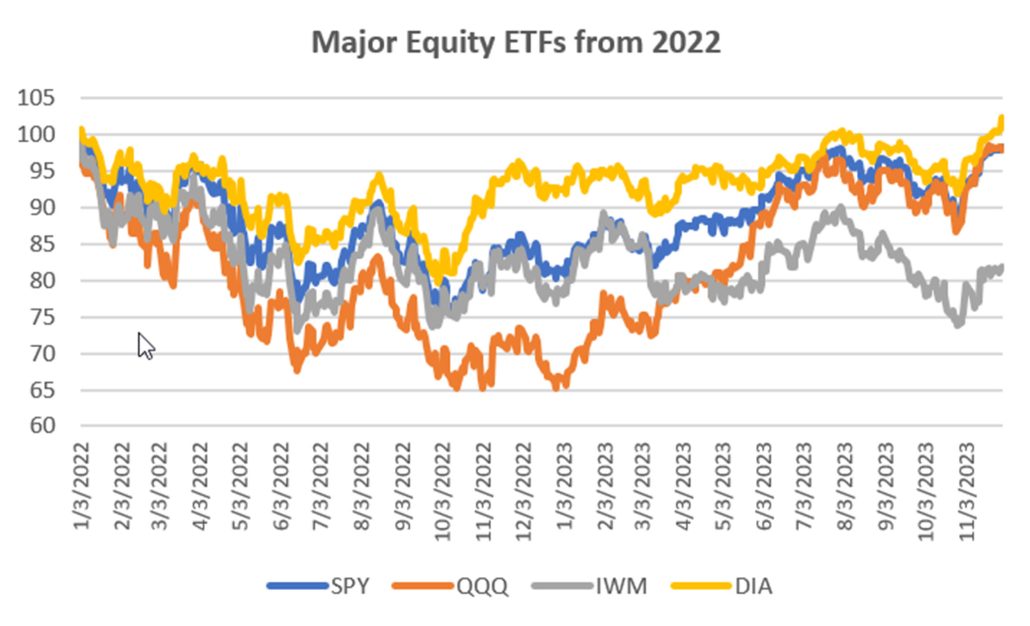
CLOSE-UP: Which Index Trades the Best? Can I Use Those Signals to Improve Trading in Other Index Markets?
I was reminded on November 12 when the small caps gained 6% in one day, that traders feel good about the economy when they buy the most risky shares. There is a theory that, when the economy is bad, investors will go to the big caps – the safest investment. When they feel optimistic, they will buy everything.
So I looked at prices during the 2008 financial crises, the bull market that followed, and our recent interest rate increase. No, it didn’t happen. The small caps, IWM, did not lead the market even during heart of the bull market that followed the financial crisis.
But looking at the charts, the index markets are well correlated. But some are more volatile and erratic to make them perform poorly even when smoothed with a moving average. What if we find the smoothest one and use those signals for the other index markets?
While at it, let’s look at which calculation periods would work during the past two years, compared to the past 20 years and find the right compromise.
Applying the Trend in One Index Market to the Others
This will involve a lot of tables, but first we will start with a chart. The top two charts represent the performance of the four major index ETFs, SPY, QQQ, DIA, and IWM. The left chart uses the calculation periods for a moving average based on the SPY data. The right uses the signals from the QQQ data. The bottom two charts use the data from DIA (left) and IWM (right).

Figure 1. Returns for the major index ETFs using SPY moving average signals (left) and QQQ signals (right).

Figure 2. Returns for the major index ETFs using DIA moving average signals (left) and IWM signals (right).
The good news is that, from 2000, they all make money. The scale on the left is the same for all charts, so it should be that the SPY seems to be most profitable and most consistent. The DIA and IWM have their best results mostly on the left and fall off to the right. Personally, I prefer results that are more uniform.
To confirm that, Table 1 shows the average of all tests, and Table 2 shows the average of each calculation period. In Table 1, the SPY has the best overall performance, with QQQ a close second. In hindsight, we can say that the SPY is most diverse, not as volatile as QQQ or IWM. DIA has only 30 stocks and may not represent the whole market.
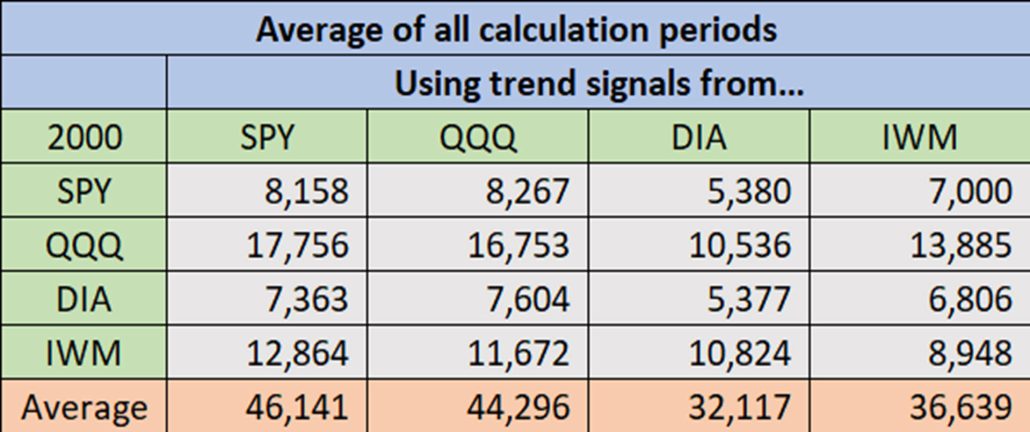
Table 1. Average of all tests using the trend signals from the top scale for the ETFs on the left scale, data from 2000.
Table 2 shows how each of the moving average calculation periods performed. The 40-day calculation periods shows the best results, but all values from 30 to 90 are much the same. Even the few outliers are close. We’ll look at this again when we review the more recent performance.
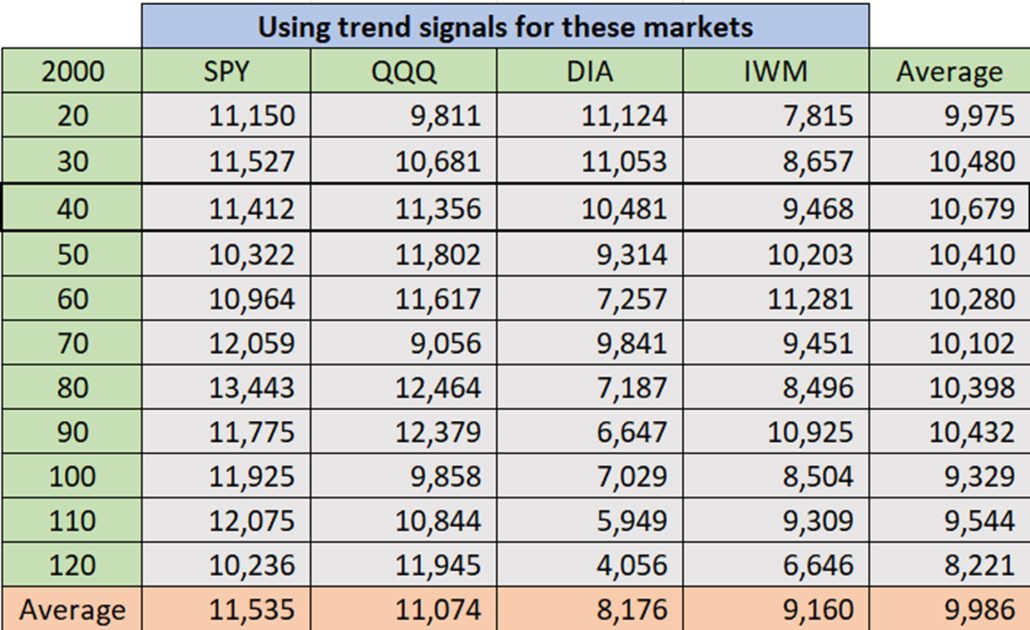
Summary of Results Using Data from 2000
Based on our tables, the SPY gives the best trading signals and could be used to trade the other major ETF index markets. QQQ comes close, but let’s now see how these same tests did for the past two years.
Data from 2021
Now we want to know how we could have done better in the past two years. Below are Figures 3 and 4, showing how the signals for one ETF worked on the other ETFs from 2021. Figure 3 (right) shows that the QQQ was more profitable than the other trend signals, posting small gains nearly everywhere. Other ETFs had gains in the faster moving averages, usually 30 days to 40 days.

Figure 3. Using SPY trend signals (left) and QQQ (right) applied to the other ETFs, from 2021.

Figure 4. Using DIA trend signals (left) and IWM (right) applied to the other ETFs, from 2021
Tables 3 and 4 show the details for the tests from 2021-2023.
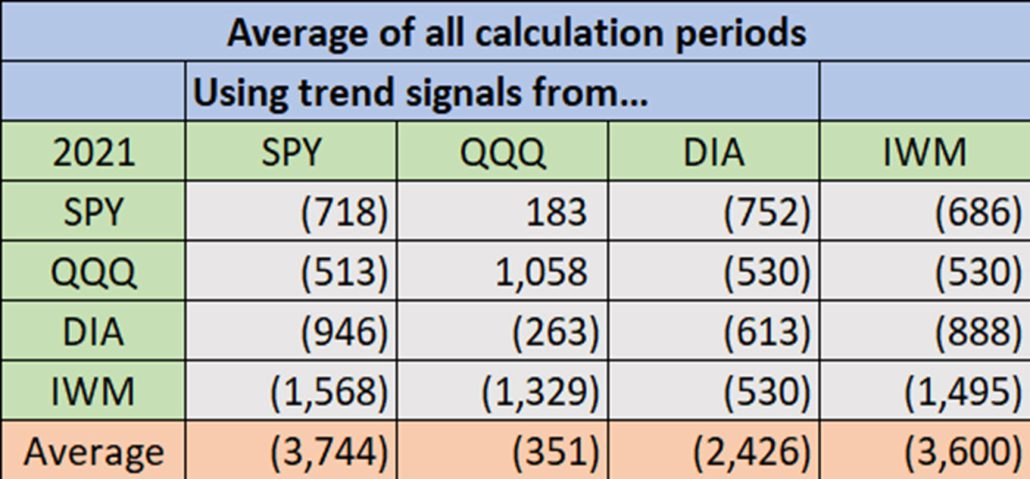
Table 3. Average of all tests using the trend signals from the top scale for the ETFs on the left scale, data from 2021.

Table 4. How each of the moving average calculation periods performed using the signals from the top scale on all four ETFs. Each value is the average of the N-day period for all four ETFs, data from 2021.
Choosing the Best
If I was trying to find the best returns for both the 2000-2023 and the 2021-2023, what would I choose? First, I start with the 2021 period because nearly all the tests from 2000 were profitable.
But the best case showed QQQ as the best signal generator (see Table 3, QQQ line). Looking at Table 4, we see that 40 days was the best overall calculation period, but 30 days had profits everywhere. Either of those two choices would be fine.
Let’s go back to the tests from 2000, Tables 1 and 2. Table 1 shows that QQQ was only slightly worse than SPY. Table 2 shows that 40 was the best QQQ calculation period.
The tables and charts show everything you need to decide whether one ETF can be used to trade the other ETFs. I would normally have expected SPY to be the choice, but the recent bear market shows that QQQ responds much better and that other markets seem to follow. Then the surprise was that calculation periods of 30 and 40 days seem to be the period most likely to succeed.
A Standing Note on Short Sales
Note that the “All Signals” reports show short sales in stocks and ETFs, even though short positions are not executed in the equity portfolios. Our work over the years shows that downturns in the stock market are most often short-lived and it is difficult to capture with a longer-term trend. The upwards bias also works against shorter-term systems unless using futures, which allows leverage. Our decision has been to take only long positions in equities and control the risk by exiting many of the portfolios when there is extreme volatility and/or an indication of a severe downturn.
PORTFOLIO METHODOLOGY IN BRIEF
Both equity and futures programs use the same basic portfolio technology. They all exploit the persistence of performance, that is, they seek those markets with good long-term and short-term returns on the specific system, rank them, then choose the best, subject to liquidity, an existing current signal, with limitations on how many can be chosen from each sector. If there are not enough stocks or futures markets that satisfy all the conditions, then the portfolio holds fewer assets. In general, these portfolios are high beta, showing higher returns and higher risk, but have had a history of consistently outperforming the broad market index in all traditional measures.
PERFORMANCE BY GROUP
NOTE that the charts show below represent performance “tracking,” that is, the oldest results since are simulated but the returns from 2013 are the systematic daily performance added day by day. Any changes to the strategies do not affect the past performance, unless noted. The system assumes 100% investment and stocks are executed on the open, futures on the close of the trading day following the signals. From time to time we make logic changes to the strategies and show how the new model performs.
Groups DE1 and WE1: Daily and Weekly Trend Program for Stocks, including Income Focus, DowHedge, and the new Sector Rotation
The Trend program seeks long-term directional changes in markets and the portfolios choose stocks that have realized profitable performance over many years combined with good short-term returns. It will hold fewer stocks when they do not meet our condition and exit the entire portfolio when there is extreme risk or a significant downturn.
It looks like the overall market wants to rally, although we expect there will be a lot of ups and downs before we see a real trend. The equity trend gained nicely in November, but we still have another month to go. Finishing on a Santa rally would be bonus.

Income Focus and Sector Rotation
A large gain in the Daily Income Focus and a small one in the Weekly program, probably due to the ability for the Daily program to switch sooner. Once a trend starts, the Weekly program will hold onto it longer.

Sector Rotation
Hard to see on the chart, but the Sector Rotation program gained over 7% in November. Interesting because it was holding Financials, Staples, and Utilities, hardly the ETFs that we would imagine gaining that much. But Utilities react mostly like bonds. Let’s see where this goes!
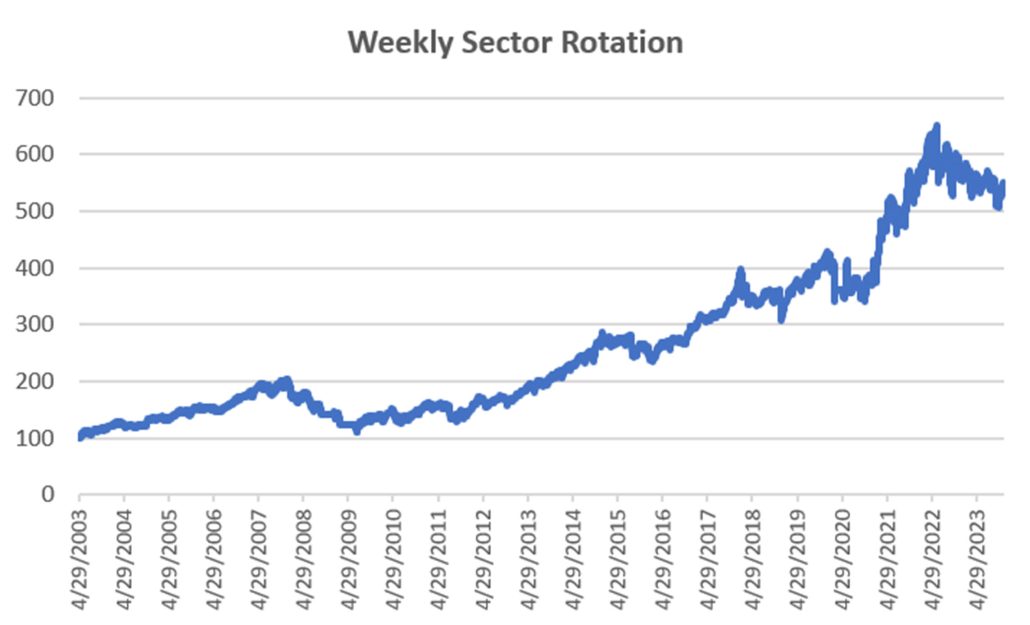
DowHedge Programs
Unlike with the other markets, the DOW gained the least so far, up by a bit over 10%. Our program is running close, up more than 7% in the Weekly and nearly 9% in the Daily for November. Both programs have come off their lows quickly, a feature that this program has been able to maintain.

Group DE2: Divergence Program for Stocks
The Divergence program looks for patterns where price and momentum diverge, then takes a position in anticipation of the pattern resolving itself in a predictable direction, often the way prices had moved before the period of uncertainty.
The Divergence Program relies on pauses in a trending pattern. Even without any major trends, the market wants to go higher. That helps this program, which gained 9.5% for the 10 stock and 4.2% for the 30 stock portfolios, putting them back in the black this year.
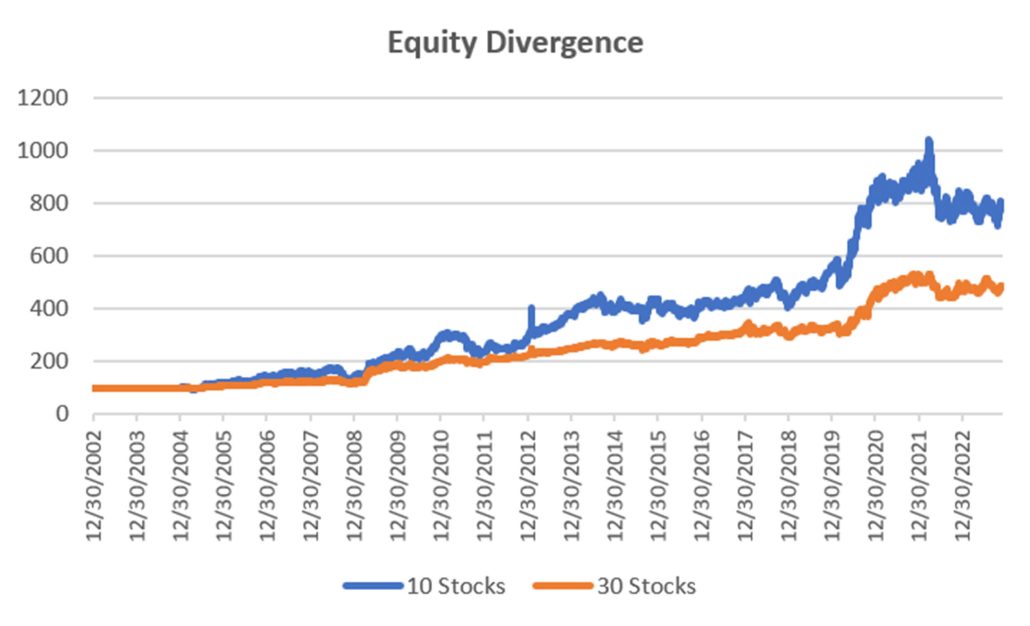
Group DE3: Timing Program for Stocks
The Timing program is a relative-value arbitrage, taking advantage of undervalued stocks relative to its index. It first finds the index that correlates best with a stock, then waits for an oversold indicator within an upwards trend. It exits when the stock price normalizes relative to the index, or the trend turns down. These portfolios are long-only because the upwards bias in stocks and that they are most often used in retirement accounts.
Gains of more than 4% in both portfolios is good given that we’ve held very few positions. This program relies on pullbacks in an uptrend. As the market moves higher, we should fill out those positions. Meanwhile, it’s doing a good job containing risk.
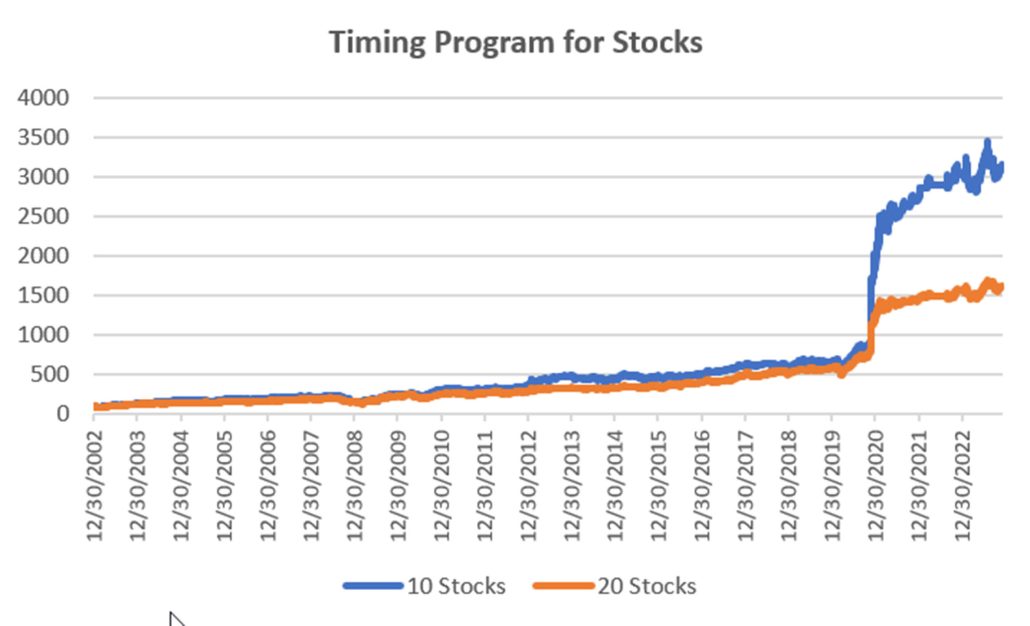
Futures Programs
Groups DF1 and WF1: Daily and Weekly Trend Programs for Futures
Futures allow both high leverage and true diversification. The larger portfolios, such as $1million, are diversified into both commodities and world index and interest rate markets, in addition to foreign exchange. Its performance is not expected to track the U.S. stock market and is a hedge in every sense because it is uncorrelated. As the portfolio becomes more diversified its returns are more stable.
The leverage available in futures markets allows us to manage the risk in the portfolio, something not possible to the same degree with stocks. This portfolio targets 14% volatility. Investors interested in lower leverage can simply scale down all positions equally in proportion to their volatility preference. Note that these portfolios do not trade Asian futures, which we believe are more difficult for U.S. investors to execute. The “US 250K” portfolio trades only U.S. futures.
Futures seem to be doing the opposite of equities. We’ve had very few positions, recently exiting the short interest rates and today going long interest rates! That’s been a long-term coming. Hopefully, December will tell us more. While this program lost 2% to 5% in November, it is still up for the year.

Group DF2: Divergence Portfolio for Futures
Small losses in November make the chart below similar to last month. The program is down 5% to 10% but a trend could change this quickly.

Blogs and Recent Publications
Perry’s books are all available on Amazon or through our website, www.kaufmansignals.com.
December 2023
This month Technical Analysis of Stocks & Commodities published “A Strategy For Trading Seasonal and Non-Seasonal Market.” Turns out that most markets are non-seasonal!
This weekend (the beginning of December) Perry is posting a new article on Seeking Alpha, “When Do You Take Profits?” It has an interesting conclusion.
November 2023
Perry posted two articles on Seeking Alpha, “Compression Breakout: Giving a Boost to Your Entries,” and “Volatility: The Second Most Important Indicator.” In addition, he interview Herb Friedman in Technical Analysis of Stocks & Commodities. Herb is a interest rate specialist focusing on low risk investments.
October 2023
In this month’s Technical Analysis of Stocks & Commodities Perry shows how Merger Arb works and how an investor can participate in it. Merger Arb has been the realm of Institutions, but there are opportunities for everyone.
August 2023
Two(!) new articles by Perry in the August issue of Technical Analysis of Stocks & Commodities. The first is a look at how ChatGPT might help traders. It even asks for a computer program to use trend following.
The second article is “Portfolio Risk Dilemma,” where Perry answers the question of whether to let a stock or futures profit run or rebalance, and whether you should do the same for a diversified portfolio.
June 2023
Another article in Technical Analysis, “Protecting Your Wealth While Making a Profit.” It shows that moving money into different world equity markets can take advantage of momentum in both price and exchange rates.
May 2023
A new post on Seeking Alpha, “Profiting From Green Energy – But Not EVs” on May 31. Shows which stocks are best for investing in energy given the moving targets.
April 2023
On April 18th, Perry gave a webinar to the Society of Technical Analysts (London) on how to develop and test a successful trading system. Check their website for more details, https://www.technicalanalysts.com..
The April issue of Technical Analysis of Stocks & Commodities published a new article by Perry, “Repatriation,” an interesting trading pattern used by FX traders but adapted for us “normal traders.”
March 2023
Perry was interviewed by Mark Ursell of Ursell of TradeInform on March 3. You can see it or listen to it on UTube https://www.youtube.com/watch?v=9gIlIIzngCk.
A new article by Perry, “Can Volume Predict Price?” in the March issue of Technical Analysis of Stocks & Commodities. You’ll need to read it to find out!
February 2023
The February 2023 issue of Technical Analysis of Stocks & Commodities published Perry’s article, “Do Small Price Changes Matter?” It tells you whether you should be ignoring those days when prices close up or down by a fraction.
Perry gave a webinar to Eduardo Lopez’ Robotrader students in Spain on Wednesday, February 8, noon (New York).
January 2023
Another year! Technical Analysis of Stocks & Commodities published “Matching the Markets to the Strategy” in the January issue. It is a look at why certain markets do best with specific strategies and why that can materially improve results.
Alejandro de Luis will publish Perry’s article “Living Off Profits,” translated into Spanish, in the January issue of his magazine, Hispatrading. It’s a good way to practice your Spanish!
Seeking Alpha posted Perry’s article, “How To Hedge Your Equity Portfolio,” showing a way to follow the Fed action.
Older Items of Interest
Perry’s webinar on risk, given to the U.K. Society of Technical Analysts, can be seen using the following link: https://vimeo.com/708691362/04c8fb70ea
For older articles please scan the websites for Technical Analysis of Stocks & Commodities, Modern Trader, Seeking Alpha, ProActive Advisor Magazine, and Forbes. You will also find recorded presentations given by Mr. Kaufman at BetterSystemTrader.com, TalkingTrading.com, FXCM.com, systemtrade.pl, the website for Alex Gerchik, Michael Covel’s website, TrendFollowing.com, and Talking Trading.com.
In May 2021, Mr. Kaufman gave a 30-minute presentation, “Lagged Trends,” for The Money Show on Tuesday, May 11. You can see it using the following link: https://youtu.be/bh2fA8oBwBk
You will also find back copies of our “Close-Up” reports on our website, www.kaufmansignals.com. You can address any questions to perry@kaufmansignalsdaily.com.
© November 2023, Etna Publishing, LLC. All Rights Reserved.
